You are here
Liebherr Group: Products & Services for Finland
Other websites for Finland
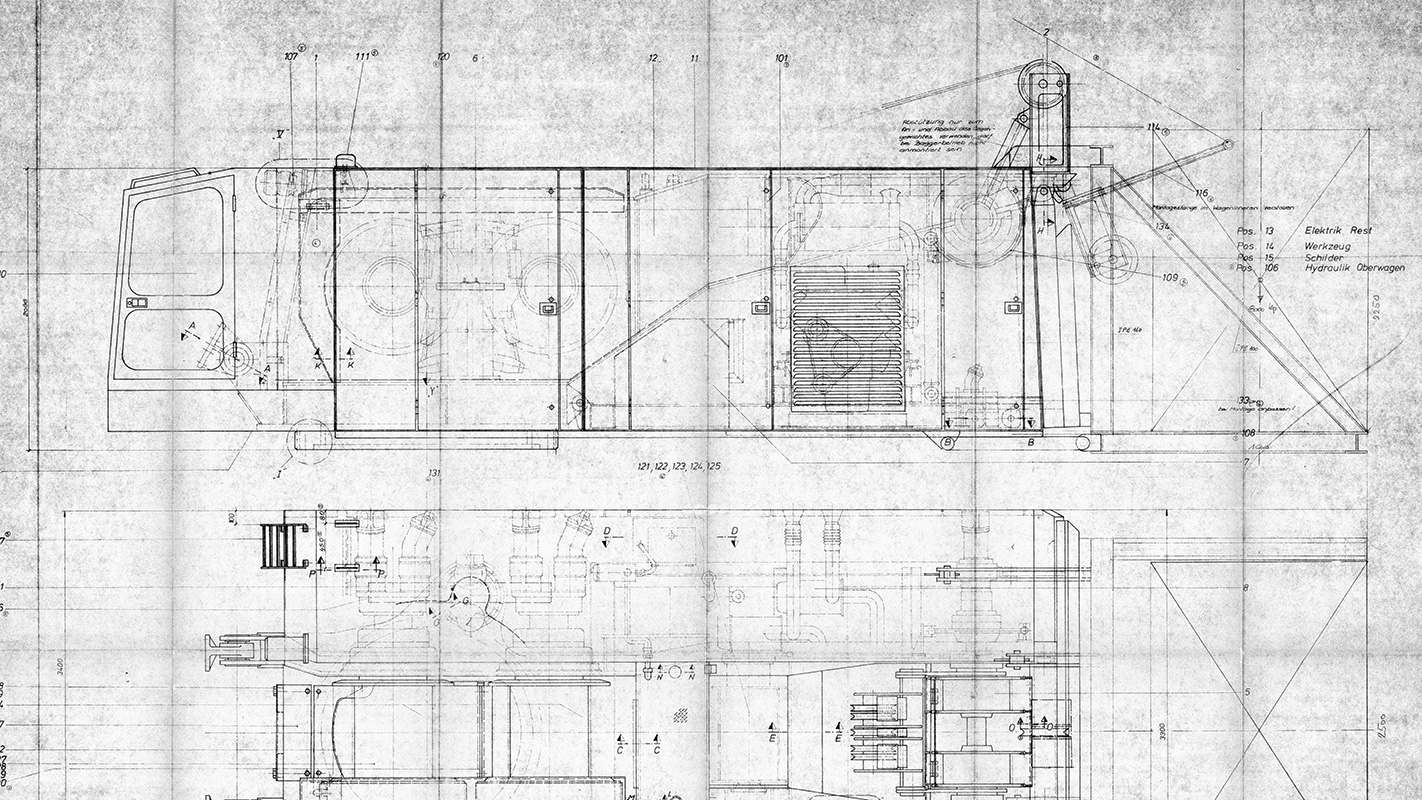
In 1979, it was a controversial topic at the ship crane manufacturer Liebherr in Nenzing – the first Liebherr duty cycle crawler crane. Yet it was to lay the foundation for the production of construction machinery at the site. After 40 years of service, the HS 870 has returned.
Manfred Brandl never thought that he would see this machine again one day. Yet the two are connected by a story that changed Liebherr. Why? Well, Liebherr-Werk Nenzing (Austria), where Manfred Brandl started as a production worker and left as managing director four decades later, very nearly developed completely differently and would almost certainly still be building ship cranes today: if it hadn’t been for this duty cycle crawler crane, which carried out lifting work in a gravel pit close to Bonn (Germany) day in, day out – rusty but steadfast, 40 years after it was built. It was discovered in 2014. The then sales manager for duty cycle and crawler cranes for Germany examined it himself and reported something unbelievable to his colleagues in Nenzing: he had the forefather of construction machine production in Nenzing in front of him – the prototype of the duty cycle crawler crane HS 870 with the serial number 181001. For Manfred Brandl, this reunion would become unforgettable.
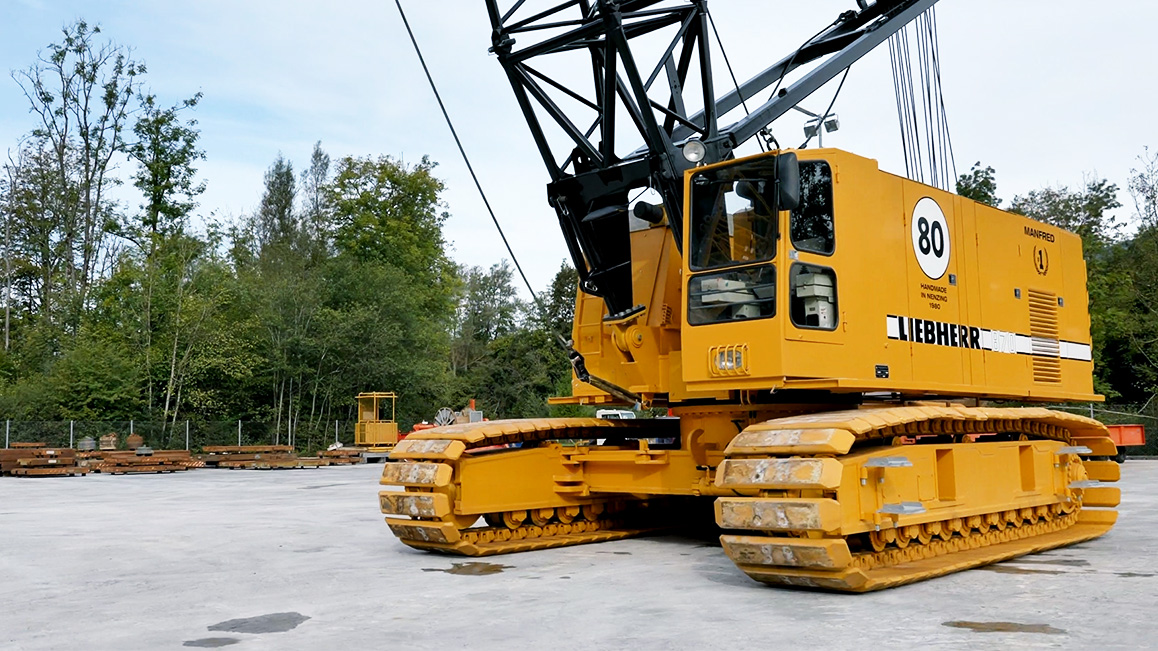
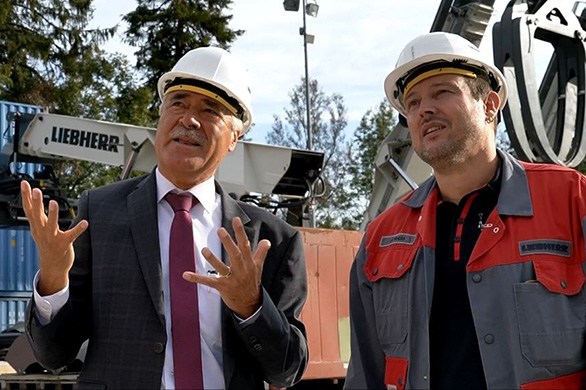
Jürgen Grass, Head of Assembly, has had to face more than one challenge in 35 years of working in construction machine development. Yet hardly any was as special as this one. He will probably always remember the homecoming of the HS 870 duty cycle crawler crane. That was in February 2018: “I can still see it before my eyes. Its condition was good, considering the circumstances. The motor and hydraulics were still working flawlessly. Nevertheless, time had left its mark on our first duty cycle crawler crane. In its 40 years of service, the machine wasn’t exactly handled delicately.” One thing was clear. If this part of Liebherr history was to be saved, more than just a fresh coat of paint would be needed.
But how do you restore a machine that established a whole era? “Since we are specialised in building new machines at Nenzing, we repeatedly had to decide just how much we wanted to restore. We wanted to preserve its character, of course. It was really hard for us not to make this vintage duty cycle crawler crane look as perfect as a new machine.”
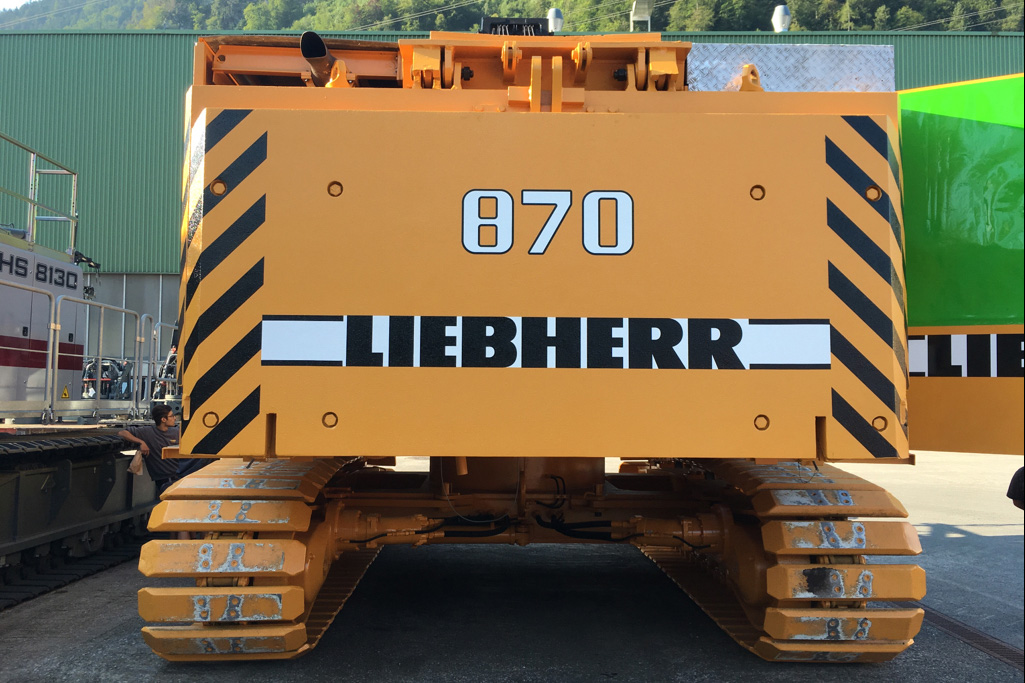
A team of mechanics, fitters, engineers and apprentices got down to business. Young and old, new and experienced employees helped and lent a hand. The undercarriage was in desolate condition and required a lot of time and attention; the travel drive had to be restored completely. The steel covering had suffered during the many years of service and was built from scratch by the apprentices. Valves were renewed, hydraulic hoses replaced and old pumps and motors were dismantled into their component parts, cleaned and reassembled. Besides original replacement parts, even high-tech from the 21st century found its way into the HS 870; despite a long search, replacement parts couldn’t be found for the headlight covers, “we then replicated them with a 3D printer, true to original,” Jürgen Grass says.
Jürgen Grass is proud of his employees. To him, the restored HS 870 is an example of what inventive talent and teamwork can accomplish. “We have many excellent and experienced employees here with us. Some of them were even involved in the construction of the HS 870, 40 years ago.” They put more than 700 hours of work into the restoration, on top of their daily work in production. A master performance during which all those involved were able to experience history up close. “This is why it was so important to us to include our apprentices in the restoration. For them, everything was particularly exciting. They could experience how our HS series first started. Today our duty cycle crawler cranes are completely digital, in 1980 everything was still analogue.”
At Liebherr-Werk Ehingen (Germany) the space became too cramped to build maritime cranes at the beginning of the 1970s. The company’s founder, Hans Liebherr, went on the lookout for a new site. He knew that if too many products were built at too small a site, there would be no room for further development. After some searching, a suitable place was found in the border triangle between Germany, Austria and Switzerland. Liebherr-Werk Nenzing was founded in 1976. In 1977, the year the first Star Wars movie came to the cinemas, production began. Less than 100 people made up the workforce and they were proud to build the Group’s ship and offshore cranes in the Alps.
In the analogue years 1979 and 1980, neither Manfred Brandl nor his colleagues would have guessed that their work was to go down as a turning point in Liebherr history. It all began when the German construction machine manufacturer Menck went bankrupt. At the same time, many different contractors approached Hans Liebherr Jr, asking whether his company could also build duty cycle crawler cranes. The company founder’s son bought the bankrupt manufacturer’s construction plans. After careful consideration, they decided to build a duty cycle crawler crane in Nenzing. And Manfred Brandl became part of the group that built it. He remembers that, initially, the prototype wasn’t popular with everyone: “We were a ship crane factory and had little to do with construction machines. The duty cycle crawler crane was a completely different product and did not really fit into the production portfolio. A few were grumbling behind closed doors.”
In spite of the naysayers, it was to be a duty cycle crawler crane, and by no means simply a Menck machine under a new name. The first Liebherr duty cycle crawler crane was to have a diesel-hydraulic drive and an electronic control system. A world’s first to be presented at Bauma 1980. However, there were only 18 months left until then. “At first, things were frantic,” says Manfred Brandl. “After all, we didn’t even know how a duty cycle crawler crane worked and to some extent, we had to define completely new manufacturing processes.” Equipped with the construction drawings of the Menck model M 750, the design engineers went to the drawing board and drafted a machine unknown to them, with novel hydraulics and a new drive system. “We mechanical fitters in production received the construction plans pretty quickly and we got started. It was only during construction that we noticed that Menck’s construction drawings were incomplete. There was a hitch in every corner.” As a group, they worked together to find the mistakes – not unlike today’s agile way of working – and together they found solutions for all the problems. “Building ship cranes is a project business. You can blindly rely on others. And that’s the only reason why we managed to build the HS 870 at maximum speed.” They even worked on their duty cycle crawler crane on the weekends – as a truly committed team.
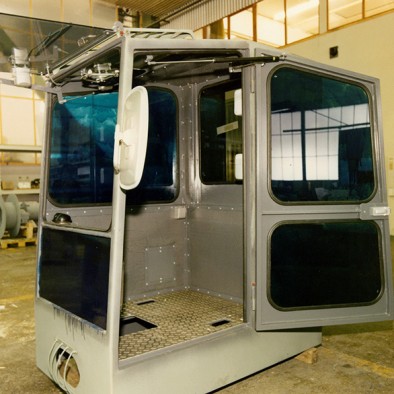 Driver's cabin
Driver's cabin
Driver's cabin
Driver's cabin
The driver's cabin is ready for assembly in 1979.
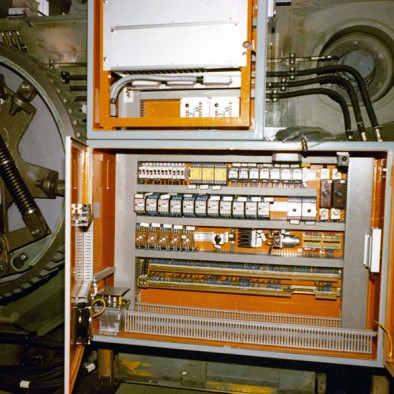 Control cabinet
Control cabinet
Control cabinet
Control cabinet
The control cabinet was equipped with the latest electronics and included all plug-in cards for processing logic and control signals.
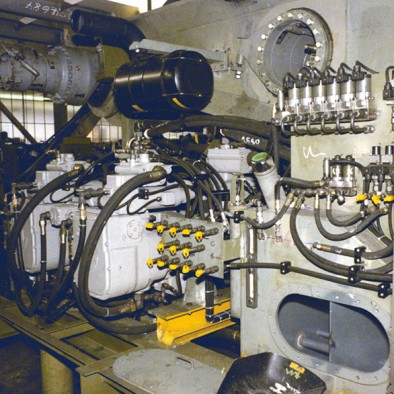 Hydraulic tank
Hydraulic tank
Hydraulic tank
Hydraulic tank
The hydraulic tank with pressure switches and control valves before painting.
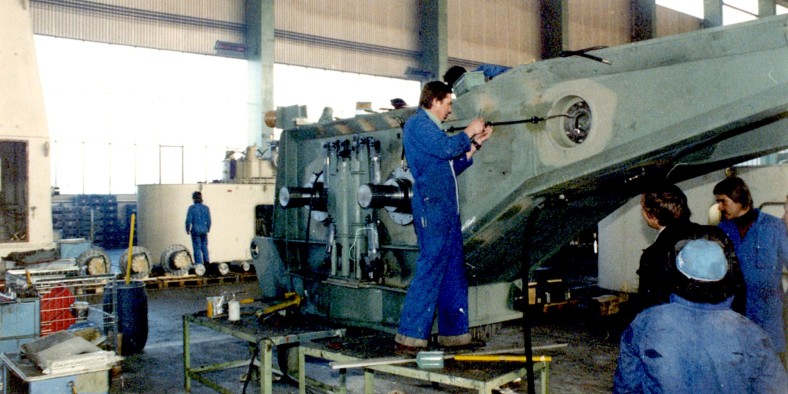 The team works on the HS 870
The team works on the HS 870
The team works on the HS 870
The team works on the HS 870
The group that built the HS 870 was a sworn team. Manfred Brandl can be seen on the right.
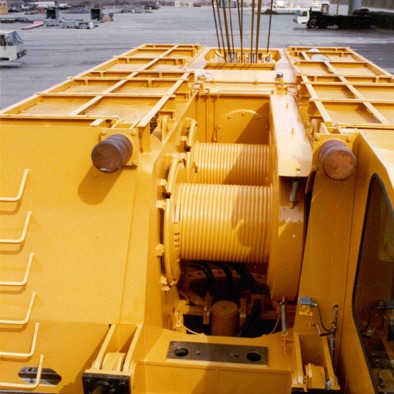 Band brake
Band brake
Band brake
Band brake
The band brake for the digging winch with tension springs for centring or relieving the strap caused some headaches.
When Manfred Brandl thinks back today, he fondly remembers the assembly, the production of the covers and the tests on the test bench. And a very particular component: that darn band brake! Without a band brake, there’s no rope winch, no rope and definitely no working duty cycle crawler crane. “I would never have thought that a small, inconspicuous component could drive us to the brink of despair. As simple as it looked, as complex was its construction.” Every time they thought they had finally found the solution for the brake, a new problem arose. Some versions saw the metal getting too hot when braking, with others, the metal simply broke or the rivets fell out. Nothing worked. “We even dreamt about it. However, when Bauma came, we had it figured out. Our motto prevailed: nothing’s impossible.”
Following the HS 870, at Bauma 1983 the HS 840 was released – and after that, a whole generation of construction machines Made in Austria. In the early 2000s, the Liebherr Rostock site was opened, where the Group’s maritime cranes are built today. Liebherr-Werk Nenzing became a reputable construction machine manufacturer. Today, its machines work on construction sites all over the world, including numerous duty cycle crawler cranes, the HS Series. The Austrians’ latest hit is the Unplugged series, battery-powered crawler cranes and deep foundation machines that are setting trends in the industry.
In April 1980, the whole group that had created Liebherr’s first duty cycle crawler crane was invited to Bauma in Munich (Germany). The prototype was not only expected to meet high standards in terms of workmanship and functionality: it also had to be visually appealing. “We cleaned and polished the machine until in the end it was presented to the world like a made-up bride on the Liebherr stand.” The group from Nenzing stood around their machine with proudly swollen chests, watched the hustle and bustle, held conversations and could hardly believe just how much praise they got. “At Bauma all the reputable construction machine manufacturers of the world present their products but our HS 870 caught the eye of the expert exhibition visitors. It was a world sensation.”
When Bauma ended, the prototype was directly handed over to its new owner Bilfinger Berger and was in active service on various construction sites for various owners all over Europe: until it was rediscovered in Bonn, 40 years later.
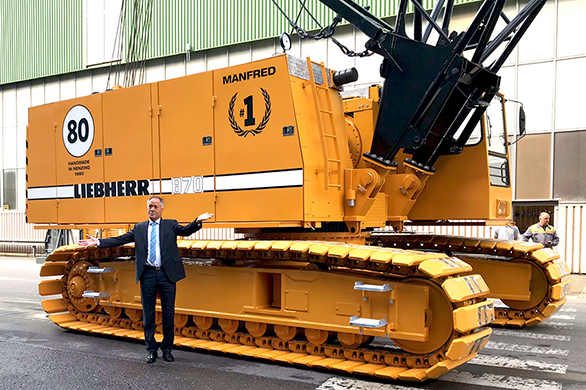
The day he said his goodbyes after more than four decades with Liebherr, the retiring Managing Director Manfred Brandl was quite astonished when his staff presented him with his namesake Manfred #1. “The restoration of the HS 870 was finished at the same time as my retirement after 42 Liebherr years. As a farewell present, so to speak, my first name now adorns this amazing machine. I’m very thankful for this and it makes me proud to be part of this Liebherr history.”
The HS 870 is staying in Nenzing where guests and employees can visit and admire it. In future, the first Liebherr duty cycle crawler crane will also be presented during customer days and events. Only one question remains: what would the prototype, the machine that laid the foundation for the construction machine production in Nenzing, say to all of this? Manfred Brandl and Jürgen Grass agree: “If the HS870 could speak, it would probably say that it owes its existence to the proverbial “Liebherr spirit” and that it is pleased to return to Nenzing for its retirement after so many years.”
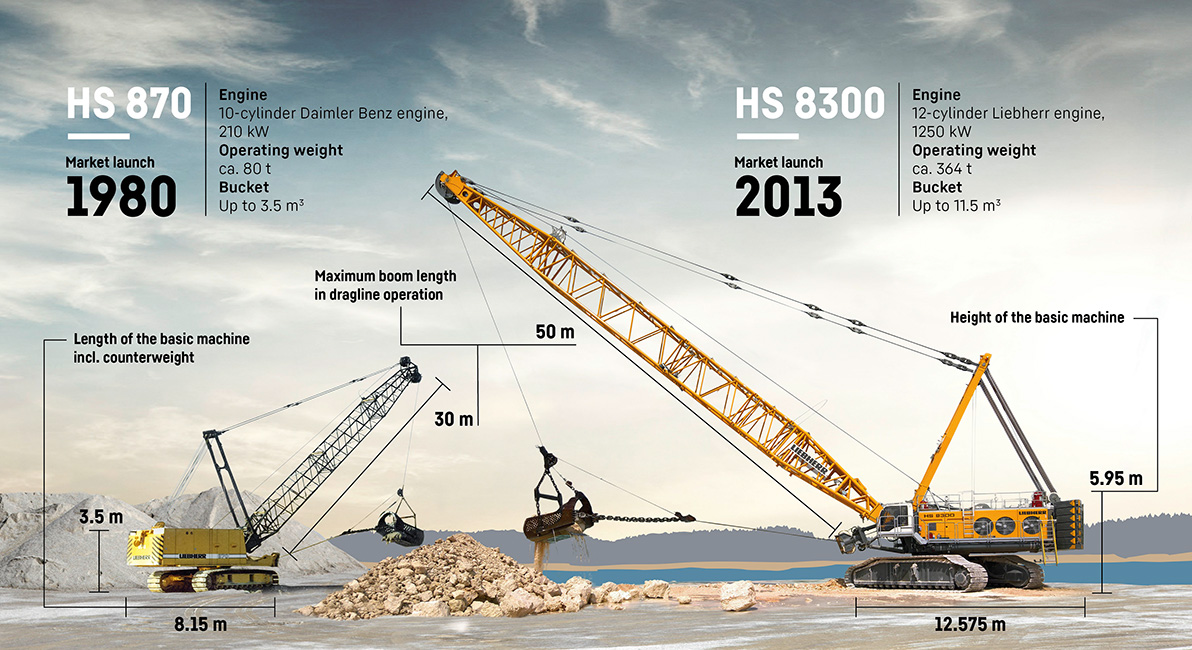
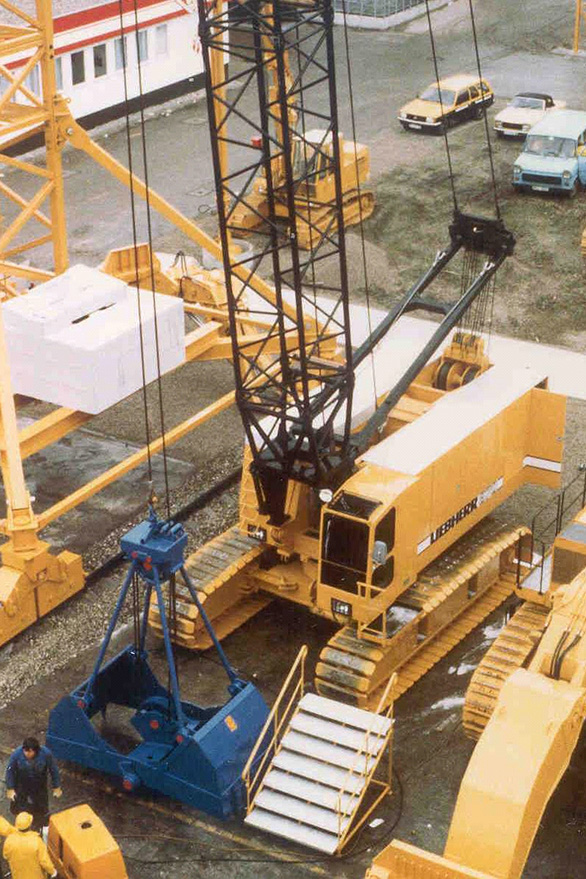
If you were looking for Bauma from 10th-16th April 1980, you could find it in the heart of Munich at Theresienwiese, which has become world-famous because of the Oktoberfest. Back then, Bauma was much quieter than we know it today. As an exhibition, it mainly attracted trade visitors and people interested in construction machinery. At the beginning of the exhibition week, the organiser, Messe München, anticipated a visitor record of 160,000 visitors. 919 exhibitors were on-site, 720 from Germany and 199 from abroad, among others from Italy, Great Britain, Switzerland, and even South Africa. In total, there were companies from 23 countries, as stated in the exhibition magazine “Bauma 80 Report Nr. 2“. The exhibition stretched over an area of 342,000 square metres. Bauma 2019, in comparison, boasted a space of 614,000 square metres.
Liebherr announced the HS 870 on April 10th in a rather technical and dry press information, but not without a certain touch of pride: “The duty cycle crawler crane Liebherr presented as a new invention at BAUMA 80 is a universal device for excavation and crane works (...). Important components such as the crawler undercarriage, the diesel-hydraulic drive for driving and working movements, and the electro-hydraulic control system, which is completely new for machines of this kind, are modern and proven technology from the areas of excavators and cranes at Liebherr. The important mechanical, hydraulic and electrical systems of the new Liebherr duty cycle crawler crane are therefore already field-tested.”

The first choice for the new production site outsourced from Ehingen would have been a harbour plot. However, such sites were scarce in the 1970s, which had led to enormous price increases. Liebherr was already a successful company but success also depends on courage and good economic management. For Hans Liebherr, a harbour plot of the corresponding size significantly exceeded the budget for his new factory. It was also important to the company founder to be able to reach all his company sites quickly. He wanted to be able to get to each of his companies easily with the help of his mobile office, a Mercedes Benz 450 SEL. And for logistics, it was important to have close access to trains and motorways. In Nenzing, Hans Liebherr found it all.